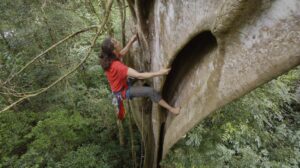On E9, margins can get pretty thin (to state the obvious).
Yes, these climbs are hard, featuring desperate sequences on tiny holds. Yes, they’re dangerous: On any ascent, there’s a real possibility of breaking bones or worse. This top end of the British severity scale pushes the physical and psychological limits of any climber.
Watching masters of the trade like Dave MacLeod is stimulating enough for anyone stoked on the genre. Painting with the broadest brush, it’s drama.
Watch a case in point, as MacLeod sessions a long-term project in Glen Nevis, Scotland. You could call the trad veteran’s key tools unorthodox in the world of hard climbs. He’s fit, sure, but he’s also extremely attentive to detail and exhaustively strategic.

MacLeod does not stint on hard work. Photo: Screenshot
All about the details
Of course, he files down a stopper for the climb he calls the Gorge Project. Does the little unit need to fit perfectly in exactly one placement? Yes, it does. That’s because MacLeod will need it to fill a critical role in a nest of marginal gear that’s the only thing protecting him from a groundfall while he busts insecure, tension-y moves above a lot of thin air.
Placing the three pieces that make up that nest is a whole other challenge in perfectionism. MacLeod notes he delicately taped the pieces to his harness (rather than clipped it on) because he figured he could shave vital seconds off their placement.
(And that’s just the first pitch of the project.)
On hard U.K. trad climbs, it’s all about the head game.
Succeeding means finding a way to manage your fear of objective danger. Some play it looser, some tighter. Johnny Dawes said, “You’ve got to put yourself in situations you absolutely should not be in,” without explaining why you shouldn’t be there. Some think Steve McClure plays tricks on not only himself but on the stone.
MacLeod’s methods, on the other hand, have always seemed laser-cut. That he’s still here to practice them, in his precisely spoken, yeoman’s manner, stands testament to their validity.






